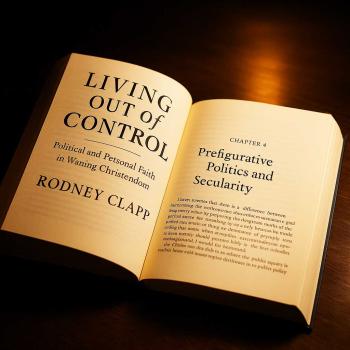Now I turn to Chapters 5 and 6–both great chapters with which I mostly agree. I think Chapter 5 especially is extremely helpful and all evangelicals should consider Smith’s (not entirely original) proposal. It won’t fix the problem of PIP, but it will go a long way toward resolving numerous difficulties we run into when we try to treat the Bible as a flat terrain without highs and lows (not of inspiration but of authority for belief and life).
Chapter 5 is entitled “The Christocentric Hermeneutical Key.” With this chapter Smith turns to proposed partial solutions to the problem of pervasive interpretive pluralism (PIP). However, I think his proposal in this chapter is valuable independently of the PIP problem.
Here’s how Smith sets up the chapter’s argument: “what is needed to improve on biblicism is some kind of stronger hermeneutical guide that can govern the proper interpretation of the multivocal, polysemous, multivalent texts of scripture toward the shared reading of a more coherent, authoritative biblical message. Such a stronger hermeneutical guide would also, of course, have to be consistent with, if not directly derived from, Christian scripture and tradition.” (95)
His proposal is this: “The purpose, center and interpretive key to scripture is Jesus Christ. … Truly believing that Jesus Christ is the real purpose, center, and interpretive key to scripture causes one to read the Bible in a way that is very different than believing the Bible to be an instruction manual containing universally applicable divine oracles concerning every possible subject it seems to address.” (97-98)
To that I can only say Amen! I have been promoting a Christocentric hermeneutic to my students for many years. Smith is not being original here and doesn’t claim to be. Luther practiced such an approach with his litmus test for biblical interpretation. For him, that is especially God’s Word to us that promotes Christ (“was Christum treibt”).
Smith makes clear that he is not advocating a kind of allegorical or typological approach to Scripture that “sees” Christ in every verse of the Old Testament (for example–the tabernacle in the wilderness and every part of it a type of Christ). Rather, his approach is this: “If believers want to rightly understand scripture, every narrative, every prayer, every proverb, every law, every Epistle needs…to be read and understood always and only in the light of Jesus Christ and God reconciling the world to himself through him.” (99) Again, to that I say Amen!
Smith rightly appeals to great theologians such as Bonhoeffer, Barth, G. C. Berkouwer, Geoffrey Bromiley, Donald Bloesch, and to contemporary theologians (some evangelical) such as John Webster and Kevin Vanhoozer.
One problem I have with Smith’s examples of Christocentric hermeneutics is his appeal to the 2000 Baptist Faith & Message of the Southern Baptist Convention. He says it includes the phrase “all Scripture is a testimony to Christ, who is Himself the focus of divine revelation.” (108) However, he fails to note that the 2000 BF&M dropped the following sentence from the 1963 BF&M (which is still the consensus statement of the Baptist General Convention of Texas): “The criterion by which the Bible is to be interpreted is Jesus Christ.” Dropping that sentence seriously weakened the phrase the 2000 BF&M kept. It is one thing to say Christ is the “focus” of divine revelation and something else entirely to say he is the “criterion” for interpretation of Scripture. The 1963 criterion phrase was dropped purposely, in my opinion, in order to strengthen the kind of biblicism Smith decries as impossible. So, if Jesus Christ is not the criterion by which the Bible is interpreted, what will be that criterion? No doubt the framers of the revisionist 2000 BF&M would say it doesn’t need one because it is wholly perspicuous. But, of course, that’s simply naive. I suggest that for them, the unacknowledged criterion is themselves–i.e., their vision of Baptist tradition. I agree with Smith about this and it applies, in my opinion, to the moves made by the SBC in its revision of the BF&M and to its leaders approach to the Bible: “The reality is that it is not possible to take fully seriously a Christocentric hermeneutic of scripture and to hold to biblicism. One or the other must give. In most cases to date, the biblicist tendencies overwhelm Christocentric gestures and intuitions. Nobody ends up explicitly denying that Christ is the purpose, center, meaning, and key to understanding scripture. But in actual practice Christ gets sidelined by the interest in defending every proposition and account as inerrant, universally applicable, contemporarily applicable, and so on, in ways that try to make the faith ‘relevant’ for everyday concerns.” (109)
What Smith doesn’t say (or say enough about) is that in these cases what takes the place of Christ as the criterion of biblical interpretation is not nothing but some tradition–whether the “ancient Christian consensus” as in paleo-orthodoxy or the “received evangelical tradition” as in conservative evangelicalism/neo-fundamentalism or the magisterium of the Catholic church as in Roman Catholicism. My question to Smith would be: Can you really practice what you preach in this chapter as a Roman Catholic?
I agree with Smith (at least the Smith of this chapter!) that a “canon within the canon” is inevitable and it ought to be Jesus Christ (was Christum treibt). If it isn’t him, it will be something or someone else. And I probably agree with Smith now (after the book was written when he joined the RCC) that there is always and must be a “canon outside the canon”–some tradition that guides us in interpretation. Where I disagree (probably) is that this canon outside the canon must be binding on our interpretation of Scripture. I say it (for me The Great Tradition of Christian teaching heralded by the church fathers and restored by the Reformers) always gets a vote (in matters of doctrinal controversy) but never a veto. Jesus, however, gets a veto! That is to say that if a doctrine conflicts with the character of God revealed in Jesus Christ, however many verses can be piled up to support it, it cannot be true.
Perhaps Smith’s most radical claim in this chapter (and perhaps in the book) is this: “The Bible is of course crucial for the Christian church and life. But it does not trump Jesus Christ as the true and final Word of God. The Bible is a secondary, subsidiary, functional, written word of God, the primary purpose of which is to mediate, to point us to, to give true testimony about the living Jesus Christ. … Biblicism borders on idolatry when it fails to maintain this perspective.” (117-118)
Again, I respond with a hearty Amen!
Smith goes on to deal with objections to Christocentric hermeneutics and he handles them very well.
Let me use Smith’s chapter and the approach it takes to explain WHY I AM NOT A CALVINIST AND CANNOT BE ONE. I am constantly besieged by critics who claim my theology–Arminianism–is exegetically weak. What I think they are saying is that they can pile up more verses for their theology than I can for mine. EVEN IF THAT WERE TRUE (which I’m not about to concede), it wouldn’t settle the issue between us. The Bible is not a textbook of truth in the way they handle it. It is inspired testimony to Jesus Christ who reveals God’s character perfectly. I see them trying to look behind Jesus Christ to some God whose character is different from Jesus’. And then they impose that mostly Old Testament view of God onto Jesus Christ and the New Testament. My first and utter loyalty is to Jesus Christ. I agree with Zinzendorf who said “If it weren’t for Jesus I wouldn’t believe in God” only I would alter it to “If it weren’t for Jesus I wouldn’t love or worship God.” Thank God for Jesus! When I look at most Calvinist attempts to prove their theology (and here I mean high, TULIP, double predestination Calvinism) what I see is an interpretation of Scripture that leaves Jesus behind; God’s character is derived from a chain of biblical passages interpreted in such a way that they are not only NOT consistent with the character of God revealed in Jesus, they positively CONFLICT with the character of God revealed in Jesus. I know this sounds shocking to biblicist ears (as Smith defines biblicism), but I agree with Wesley who said of the Calvinist interpretation of Romans 9 “Whatever it means, it cannot mean that!” Why not? Because of Jesus Christ.
Now don’t jump on me for sentimentalizing God and Jesus. Sure, God revealed in Jesus is intolerant of evil and judges it. But he is a God who loves his human creatures, created in his own image and likeness, and wants them all to be saved and has done everything in his power to save them. If they are not saved it is because they prefer to remain in the “far country” than to return home to the waiting father with his open arms.
Next time…Chapter 6 “Accepting Complexity and Ambiguity”











